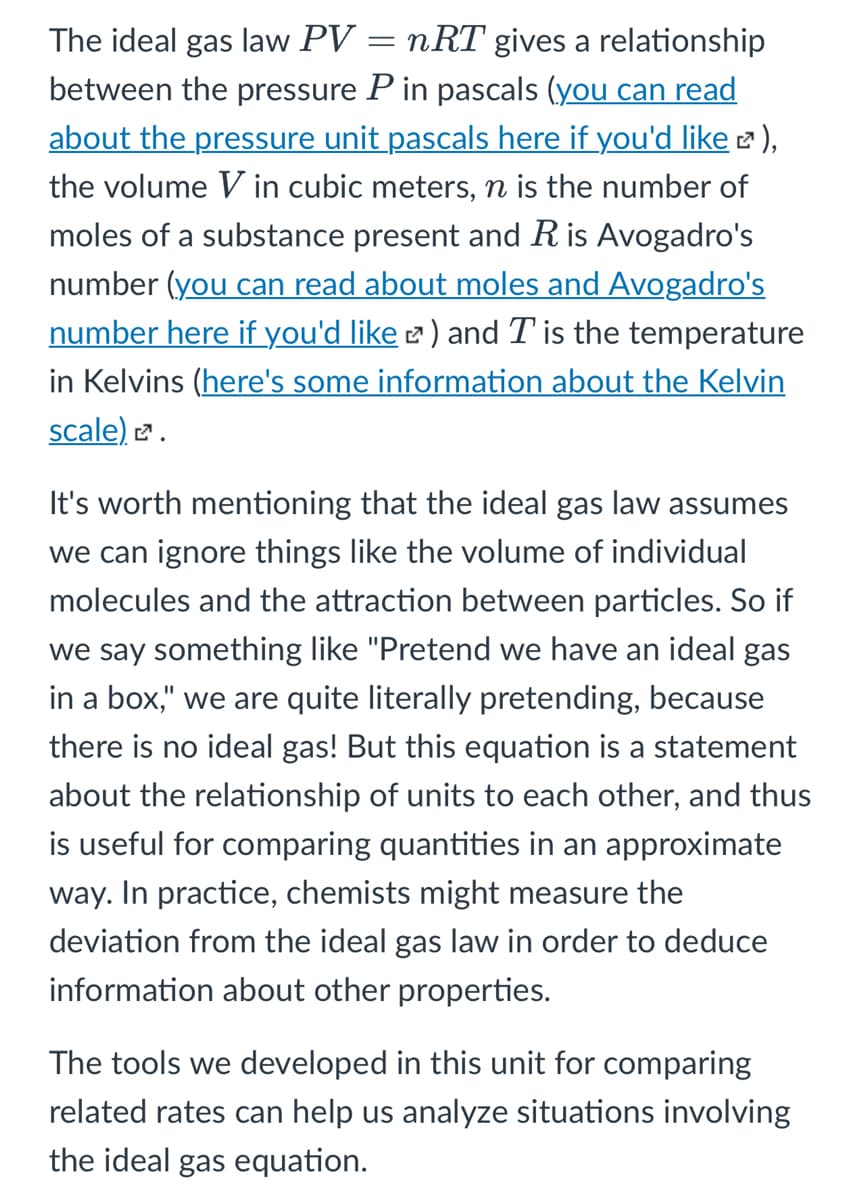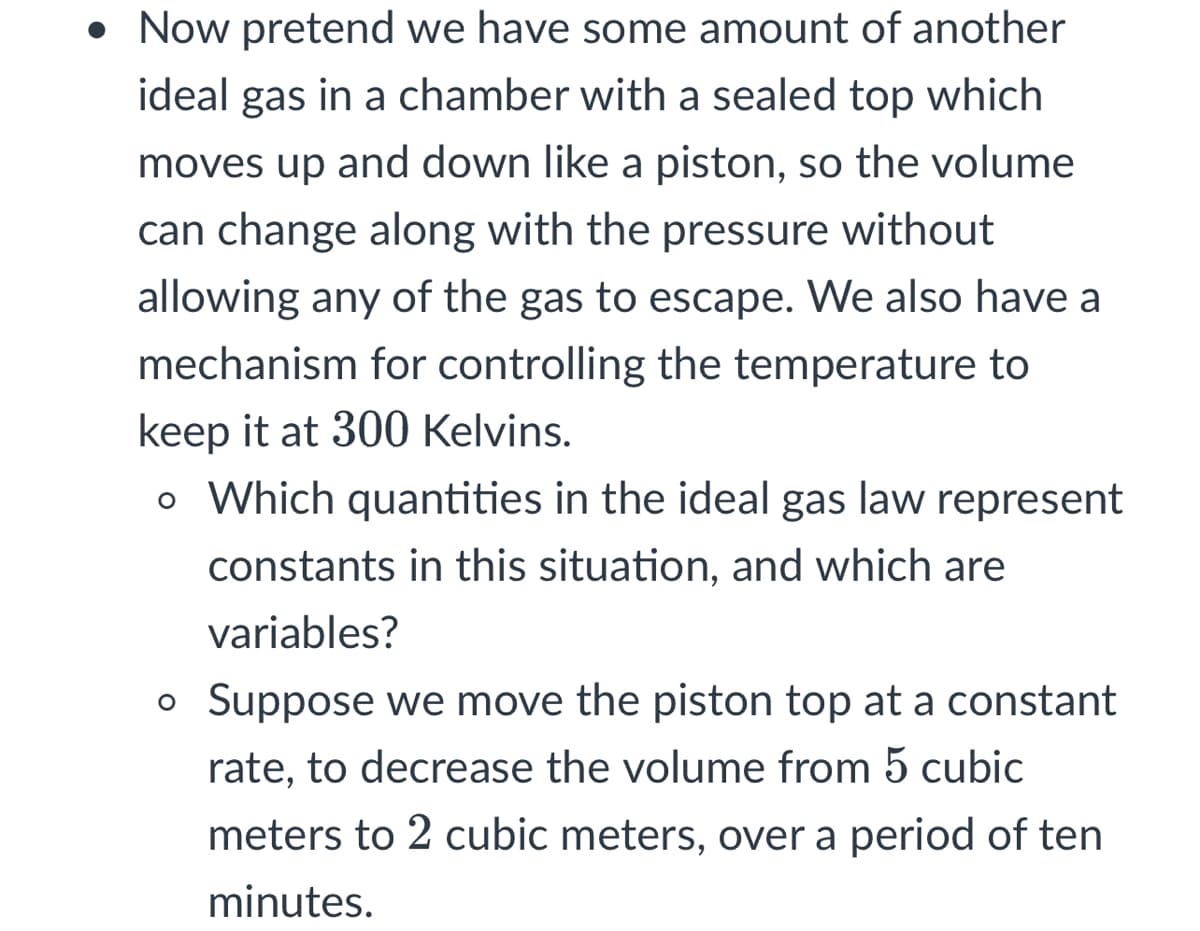• Now pretend we have some amount of another ideal gas in a chamber with a sealed top which moves up and down like a piston, so the volume can change along with the pressure without allowing any of the gas to escape. We also have a mechanism for controlling the temperature to keep it at 300 Kelvins. o Which quantities in the ideal gas law represent constants in this situation, and which are variables? Suppose we move the piston top at a constant rate, to decrease the volume from 5 cubic meters to 2 cubic meters, over a period of ten minutes.
• Now pretend we have some amount of another ideal gas in a chamber with a sealed top which moves up and down like a piston, so the volume can change along with the pressure without allowing any of the gas to escape. We also have a mechanism for controlling the temperature to keep it at 300 Kelvins. o Which quantities in the ideal gas law represent constants in this situation, and which are variables? Suppose we move the piston top at a constant rate, to decrease the volume from 5 cubic meters to 2 cubic meters, over a period of ten minutes.
Chemistry & Chemical Reactivity
10th Edition
ISBN:9781337399074
Author:John C. Kotz, Paul M. Treichel, John Townsend, David Treichel
Publisher:John C. Kotz, Paul M. Treichel, John Townsend, David Treichel
Chapter10: Gases And Their Properties
Section: Chapter Questions
Problem 105IL: You have a gas, one of the three known phosphorus-fluorine compounds (PF3, PF3, and P2F4). To find...
Related questions
Question

Transcribed Image Text:The ideal gas law PV = nRT gives a relationship
between the pressure P in pascals (you can read
about the pressure unit pascals here if you'd like 2),
the volume V in cubic meters, n is the number of
moles of a substance present and R is Avogadro's
number (you can read about moles and Avogadro's
number here if you'd like 2 ) and T is the temperature
in Kelvins (here's some information about the Kelvin
scale) 2.
It's worth mentioning that the ideal gas law assumes
we can ignore things like the volume of individual
molecules and the attraction between particles. So if
we say something like "Pretend we have an ideal gas
in a box," we are quite literally pretending, because
there is no ideal gas! But this equation is a statement
about the relationship of units to each other, and thus
is useful for comparing quantities in an approximate
way. In practice, chemists might measure the
deviation from the ideal gas law in order to deduce
information about other properties.
The tools we developed in this unit for comparing
related rates can help us analyze situations involving
the ideal gas equation.

Transcribed Image Text:• Now pretend we have some amount of another
ideal gas in a chamber with a sealed top which
moves up and down like a piston, so the volume
can change along with the pressure without
allowing any of the gas to escape. We also have a
mechanism for controlling the temperature to
keep it at 300 Kelvins.
o Which quantities in the ideal gas law represent
constants in this situation, and which are
variables?
Suppose we move the piston top at a constant
rate, to decrease the volume from 5 cubic
meters to 2 cubic meters, over a period of ten
minutes.
Expert Solution
Step 1
Ideal gas equation
PV = nRT.
P:- pressure .
V :- volume .
n :- moles of gas
R:- gas constant
T:- temperature in Kelvin
Step by step
Solved in 3 steps

Knowledge Booster
Learn more about
Need a deep-dive on the concept behind this application? Look no further. Learn more about this topic, chemistry and related others by exploring similar questions and additional content below.Recommended textbooks for you

Chemistry & Chemical Reactivity
Chemistry
ISBN:
9781337399074
Author:
John C. Kotz, Paul M. Treichel, John Townsend, David Treichel
Publisher:
Cengage Learning

Chemistry & Chemical Reactivity
Chemistry
ISBN:
9781133949640
Author:
John C. Kotz, Paul M. Treichel, John Townsend, David Treichel
Publisher:
Cengage Learning

Chemistry: The Molecular Science
Chemistry
ISBN:
9781285199047
Author:
John W. Moore, Conrad L. Stanitski
Publisher:
Cengage Learning

Chemistry & Chemical Reactivity
Chemistry
ISBN:
9781337399074
Author:
John C. Kotz, Paul M. Treichel, John Townsend, David Treichel
Publisher:
Cengage Learning

Chemistry & Chemical Reactivity
Chemistry
ISBN:
9781133949640
Author:
John C. Kotz, Paul M. Treichel, John Townsend, David Treichel
Publisher:
Cengage Learning

Chemistry: The Molecular Science
Chemistry
ISBN:
9781285199047
Author:
John W. Moore, Conrad L. Stanitski
Publisher:
Cengage Learning

General Chemistry - Standalone book (MindTap Cour…
Chemistry
ISBN:
9781305580343
Author:
Steven D. Gammon, Ebbing, Darrell Ebbing, Steven D., Darrell; Gammon, Darrell Ebbing; Steven D. Gammon, Darrell D.; Gammon, Ebbing; Steven D. Gammon; Darrell
Publisher:
Cengage Learning

Physical Chemistry
Chemistry
ISBN:
9781133958437
Author:
Ball, David W. (david Warren), BAER, Tomas
Publisher:
Wadsworth Cengage Learning,

Chemistry: Principles and Reactions
Chemistry
ISBN:
9781305079373
Author:
William L. Masterton, Cecile N. Hurley
Publisher:
Cengage Learning